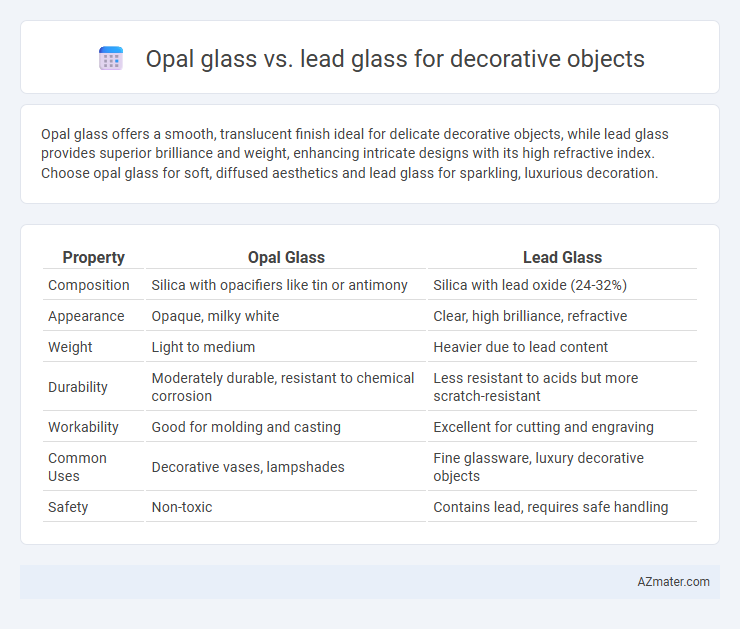Opal glass offers a smooth, translucent finish ideal for delicate decorative objects, while lead glass provides superior brilliance and weight, enhancing intricate designs with its high refractive index. Choose opal glass for soft, diffused aesthetics and lead glass for sparkling, luxurious decoration.
Table of Comparison
| Property | Opal Glass | Lead Glass |
|---|---|---|
| Composition | Silica with opacifiers like tin or antimony | Silica with lead oxide (24-32%) |
| Appearance | Opaque, milky white | Clear, high brilliance, refractive |
| Weight | Light to medium | Heavier due to lead content |
| Durability | Moderately durable, resistant to chemical corrosion | Less resistant to acids but more scratch-resistant |
| Workability | Good for molding and casting | Excellent for cutting and engraving |
| Common Uses | Decorative vases, lampshades | Fine glassware, luxury decorative objects |
| Safety | Non-toxic | Contains lead, requires safe handling |
Introduction to Decorative Glass Types
Opal glass features a milky, opaque appearance achieved by adding fluorides and phosphates, making it ideal for decorative objects with a soft, diffused light effect. Lead glass, known for its high refractive index and clarity due to lead oxide content, offers superior brilliance and weight, enhancing the aesthetics of luxury decorative pieces. Both types serve distinct decorative purposes: opal glass emphasizes subtle elegance and light diffusion, while lead glass is favored for its sparkling transparency and intricate detailing.
What Is Opal Glass?
Opal glass is a type of opaque or translucent glass characterized by its milky white appearance, created by adding opacifiers such as tin oxide or bone ash during production. It is often used in decorative objects and lighting fixtures for its soft, diffused glow and smooth surface, providing an elegant alternative to clear or colored glass. Compared to lead glass, which contains lead oxide for higher refractive index and brilliance, opal glass emphasizes subtlety and muted aesthetics ideal for vintage or modern decorative designs.
What Is Lead Glass?
Lead glass, also known as lead crystal, is a type of glass that contains lead oxide, typically between 18% and 40%, which enhances its refractive index and brilliance, making it ideal for decorative objects. This composition increases the glass's weight, clarity, and ability to be intricately cut or engraved, contributing to its popularity in fine craftsmanship and luxury decorative items. Unlike opal glass, which is opaque and milky, lead glass is transparent and sparkles with a distinctive clarity, emphasizing its use in ornamental pieces where light reflection is a key feature.
Opal Glass vs Lead Glass: Visual Differences
Opal glass features a milky, opaque appearance with soft, diffused light transmission, making it ideal for creating subtle, elegant decorative objects. In contrast, lead glass is characterized by its high clarity, brilliance, and sparkling refraction due to its high lead oxide content, offering a more transparent and radiant look. The visual difference lies in opal glass's muted, pastel tones versus lead glass's clear, reflective quality that enhances decorative intricacy.
Durability and Strength Comparison
Opal glass offers moderate durability with a smooth, opaque finish suitable for delicate decorative objects, while lead glass provides superior strength and resilience due to its higher lead oxide content, making it less prone to chipping and cracking. The increased density of lead glass enhances its impact resistance and longevity, ideal for heirloom-quality pieces that require robust durability. Opal glass is more susceptible to everyday wear, whereas lead glass maintains its structural integrity over extended use.
Safety Aspects: Lead Content vs Non-Toxic Options
Opal glass offers a safer alternative to lead glass for decorative objects due to its non-toxic, lead-free composition, reducing health risks associated with lead exposure. Lead glass, while prized for its brilliance and clarity, contains high levels of lead oxide, which can leach harmful substances over time, posing potential hazards during handling and in household environments. Choosing opal glass ensures compliance with strict safety regulations and provides a non-toxic option ideal for eco-conscious consumers seeking both beauty and health safety in decorative items.
Artistic Applications and Aesthetic Appeal
Opal glass offers a smooth, milky translucency ideal for diffusing light in decorative objects, creating a soft and ethereal aesthetic favored in contemporary artistic applications. Lead glass, enriched with high lead oxide content, provides exceptional clarity and brilliance, enhancing the sparkle and depth of sculptural details in luxury decorative pieces. Artists choose opal glass for its subtle, diffuse glow, while lead glass is preferred for intricate designs requiring high refractive index and optical precision.
Cost and Availability of Opal vs Lead Glass
Opal glass is generally more affordable and widely available than lead glass, making it a popular choice for decorative objects in mass production. Lead glass, known for its brilliance and higher refractive index, often incurs greater manufacturing costs due to the lead content and stricter regulations around its use. While lead glass is less common and pricier, opal glass offers consistent supply and cost-efficiency in decorative applications.
Maintenance and Longevity Considerations
Opal glass offers superior resistance to staining and scratching, making it easier to maintain and ideal for decorative objects exposed to regular handling. Lead glass, known for its brilliance and clarity, requires careful cleaning to prevent corrosion and preserve its sparkling appearance over time. Both types demand gentle cleaning with appropriate solutions, but opal glass generally provides greater durability and lower long-term maintenance costs.
Choosing the Best Glass for Decorative Objects
Opal glass offers a smooth, milky appearance with excellent light diffusion, making it ideal for decorative objects that require a soft, uniform glow. Lead glass provides superior clarity and brilliance due to its high refractive index, enhancing the sparkle and elegance of ornamental pieces. Choosing the best glass depends on the desired aesthetic effect: opal glass suits subtle, diffused lighting designs, while lead glass excels in creating dazzling, crystal-like decorative items.

Infographic: Opal glass vs Lead glass for Decorative object
 azmater.com
azmater.com